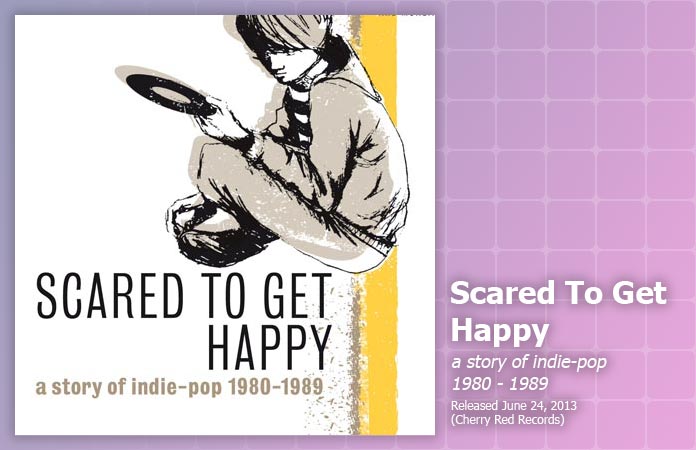Music Review: Scared To Get Happy: A Story of Indie-Pop 1980 – 1989
Published on August 5th, 2013 in: Current Faves, Music, Music Reviews, Retrovirus, Reviews |Scared To Get Happy takes on the daunting task of documenting the evolution of indie-pop in the 1980s. Given the diversity of styles that can fall under the indie-pop umbrella, a comprehensive study of all facets of the genre would be nearly impossible, especially in the span of five discs. But the compilation makes things more manageable by limiting its scope. Focusing exclusively on British artists and evoking a particular time and place in musical history, it endeavors to tell a story rather than be a definitive guide.
Eclecticism ruled supreme in ’80s indie-pop, ranging from the a cappella simplicity of Jane’s “It’s a Fine Day” to the jazzy sophisti-pop of The Weekend to the raw energy of We’ve Got a Fuzzbox and We’re Gonna Use It!! Psychedelica was embraced in much of the Creation Records roster and in bands like Rosemary’s Children and The Telescopes, while proto-shoegaze, Brit-pop, and twee-pop were evident in bands like Whirl, The Claim, Talulah Gosh, and The Boy Hairdressers. But despite these seemingly disparate sounds, the common thread between the 130+ songs on Scared To Get Happy is a willingness to experiment and push the boundaries of traditional pop.
Of course, the compilation takes from the best of the indie labels at the time, with healthy doses of music from Postcard, Sarah, Cherry Red, Rough Trade, Creation, NME’s mail-order C86 cassette series, etc. The artist lineup can at times feel like a roll call of familiar indie-pop touchstones: The La’s, Josef K, Prefab Sprout, Aztec Camera, Lloyd Cole & the Commotions, The Jesus and Mary Chain, The Wedding Present, The House of Love, The Stone Roses, The Inspiral Carpets, The Boo Radleys. However, some familiar names like Black, Pulp, Pop Will Eat Itself, and The Shamen are presented in their early days, when their sounds were strikingly different.
The best part of digging into these five discs, though, is discovering the less-familiar artists. Lost classics suddenly emerge, like the pure pop of The Brilliant Corners’ “Delilah Sands,” the sophisticated ’60s mod sounds of The Would-Be-Goods’ “Cecil Beaton’s Scrapbook,” or The Siddeleys’ haunting, chiming guitar pop. Little oddities also abound. Bad Dream Fancy Dress create “a mini psych-pop opera” in “Choirboys Gas (Hack The Cassock),” while the King of Luxembourg’s Simon Fisher Turner delivers a quirky cover of the Go-Betweens’ “Lee Remick.”
Scared To Get Happy also allows the listener to trace the evolution of indie-pop, as bands splinter and intersect. The Marine Girls dissolve, but go on to spawn Everything But the Girl and Grab Grab the Haddock. Tim and Laetitia abandon McCarthy to form Stereolab. The Sun and the Moon emerge from the remnants of The Chameleons. Bradford opens for The Smiths and his “Skin Storm” is then later covered by Morrissey. It is a fascinating exercise in indie-pop connect-the-dots.
Unsurprisingly, there are some glaring absences in the collection, mostly due to licensing issues. So, we are left without Orange Juice, Felt, The Smiths, and other seminal bands. The compilers are also occasionally a bit too clever for their own good, throwing in maybe too many obscurities and unknown bands. But ultimately, the story of Scared To Get Happy is a compelling and rewarding one.
Scared To Get Happy: A Story of Indie-Pop 1980 – 1989 was released by Cherry Red Records on June 24 and can be purchased from the label’s website.

Time limit is exhausted. Please reload the CAPTCHA.